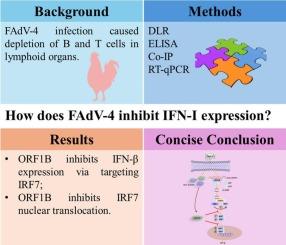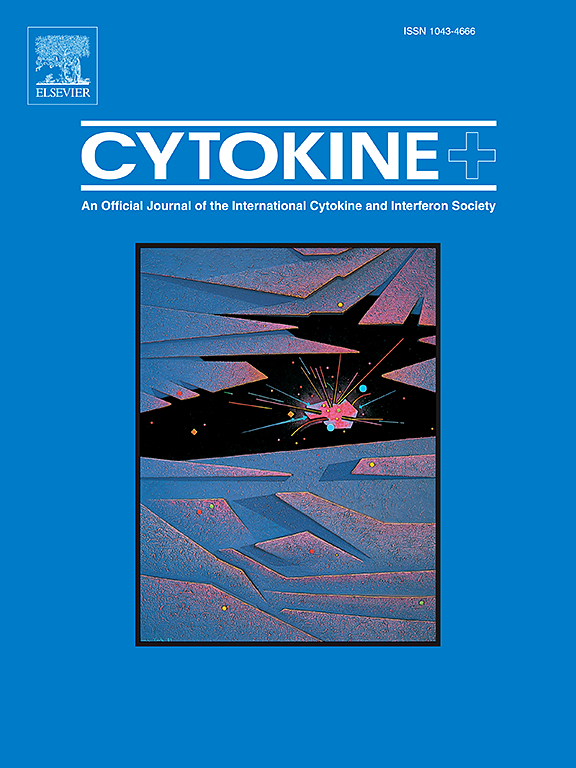禽腺病毒血清4型ORF1B蛋白通过抑制IRF7核易位抑制I型干扰素的产生
IF 3.7
3区 医学
Q2 BIOCHEMISTRY & MOLECULAR BIOLOGY
引用次数: 0
摘要
家禽腺病毒血清型4 (FAdV-4),肝炎心包积液综合征(HHS)的病原体,已被报道对抗宿主先天免疫反应。然而,FAdV-4阻断细胞抗病毒防御的潜在机制尚不清楚。通过功能筛选,我们在鸡成纤维细胞中发现了3个FAdV-4蛋白,它们可以拮抗poly (dA:dT)和cGAS/STING诱导的干扰素(IFN-β)的产生。其中,FAdV-4特有的非结构蛋白ORF1B通过靶向干扰素调节因子7 (IRF7)表现出最强的抑制作用。进一步的数据发现ORF1B与IRF7相互作用抑制其核易位。异位表达IRF7阻断了FAdV-4的复制,病毒滴度和病毒蛋白合成显著低于对照组。相反,敲低IRF7可促进FAdV-4在体外的复制。这些发现阐明了FAdV-4逃避宿主抗病毒免疫的潜在机制。本文章由计算机程序翻译,如有差异,请以英文原文为准。

Fowl adenovirus serotype 4 ORF1B protein suppresses type I interferon production by inhibiting IRF7 nuclear translocation
Fowl adenovirus serotype 4 (FAdV-4), the causative agent of hepatitis-hydropericardium syndrome (HHS), has been reported to counter the host innate immune response. However, the underlying mechanisms employed by FAdV-4 to block cellular antiviral defense remain unclear. With a functional screen, we identified three FAdV-4 proteins that antagonized beta interferon (IFN-β) production induced by poly (dA:dT) and cGAS/STING in chicken fibroblasts. Specifically, the FAdV-4 unique nonstructural protein ORF1B exhibited the strongest inhibitory effect by targeting interferon regulatory factor 7 (IRF7). Further data found that ORF1B interacted with IRF7 to inhibit its nuclear translocation. Ectopic expression of IRF7 blocked the replication of FAdV-4, with virus titers and viral protein synthesis greatly lower than those of the control group. Conversely, knockdown of IRF7 promoted FAdV-4 replication in vitro. These findings illustrate the potential mechanism that allows FAdV-4 to evade host antiviral immunity.
求助全文
通过发布文献求助,成功后即可免费获取论文全文。
去求助
来源期刊

Cytokine
医学-免疫学
CiteScore
7.60
自引率
2.60%
发文量
262
审稿时长
48 days
期刊介绍:
The journal Cytokine has an open access mirror journal Cytokine: X, sharing the same aims and scope, editorial team, submission system and rigorous peer review.
* Devoted exclusively to the study of the molecular biology, genetics, biochemistry, immunology, genome-wide association studies, pathobiology, diagnostic and clinical applications of all known interleukins, hematopoietic factors, growth factors, cytotoxins, interferons, new cytokines, and chemokines, Cytokine provides comprehensive coverage of cytokines and their mechanisms of actions, 12 times a year by publishing original high quality refereed scientific papers from prominent investigators in both the academic and industrial sectors.
We will publish 3 major types of manuscripts:
1) Original manuscripts describing research results.
2) Basic and clinical reviews describing cytokine actions and regulation.
3) Short commentaries/perspectives on recently published aspects of cytokines, pathogenesis and clinical results.
 求助内容:
求助内容: 应助结果提醒方式:
应助结果提醒方式:


